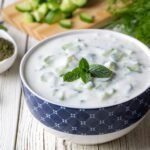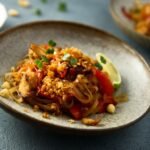Introduction to Baklava
Baklava is a rich, sweet dessert pastry that has captured the hearts of many around the world. Known for its flaky texture and nutty flavor, baklava is made through a meticulous layering of phyllo dough, filled with chopped nuts, and sweetened with syrup or honey. Its origins can be traced back to the Ottoman Empire, where it was crafted as a delicacy to be enjoyed by royalty and the elite. Over the centuries, baklava has evolved and adapted across various cultures, leading to a myriad of regional variations that reflect local ingredients and culinary traditions.
The primary ingredients of baklava typically include phyllo dough, walnuts, pistachios, or almonds, along with butter and syrup, which is often flavored with rosewater or orange blossom. These components combine to create layers of flavor and texture, making baklava a unique and delightful treat. It is traditionally cut into diamond or square shapes for easier serving, and its presentation often includes an elegant drizzle of syrup.
Baklava holds a significant place in many cultural celebrations, especially during holidays and special occasions. In Middle Eastern and Mediterranean traditions, it is often served during festivities such as Ramadan or the celebration of weddings. The preparation of this dessert is often a communal activity, where family and friends come together to create this time-honored recipe. The process of making baklava is not merely about crafting a dessert; it is an experience steeped in history and cultural practice.
As one explores the diverse landscape of baklava recipes, it becomes evident that this dessert is more than just a sweet indulgence; it is a testament to culinary heritage and a cherished symbol of hospitality. Each region’s take on baklava provides a glimpse into its history and the significance it holds within different communities.
Gathering Ingredients and Equipment

Creating a delicious baklava requires a thoughtful selection of ingredients and the right kitchen equipment. To achieve the perfect balance of flavors and textures, begin by gathering the essential components which include phyllo dough, nuts, butter, sugar, and spices. High-quality ingredients play a crucial role in the overall success of your baklava recipe. Phyllo dough, a staple in baklava, can typically be found in the frozen section of supermarkets or specialty grocery stores. Ensure you choose a brand that is fresh, as this will impact the tenderness of the pastry once baked.
When it comes to nuts, traditionally walnuts, pistachios, or almonds are utilized in baklava. You can find these in their raw or roasted forms at local markets or health food stores. If you have allergies or dietary preferences, consider substituting with pecans or sunflower seeds. The flavor is further enhanced with spices such as cinnamon or cardamom, which can often be sourced from the spice aisle of your grocery store or purchased from specialty spice retailers for an aromatic depth.
Equally important is the selection of the kitchen equipment required to assemble and bake your baklava. A sturdy baking dish, preferably 9×13 inches, is essential for accommodating the layers of phyllo dough and filling. A sharp knife is necessary to cut the baklava into the desired shapes before baking, ensuring that each piece bakes evenly. Mixing bowls and a pastry brush are also key tools, allowing for the efficient layering of butter and phyllo. With these ingredients and tools at your disposal, you will be adequately prepared to dive into the delightful and intricate process of making baklava. As you prepare, remember that the quality and freshness of your ingredients will directly impact the outcome, so take care in your selections for the best possible result.
Step-by-Step Baklava Preparation

Creating baklava requires a careful approach to ensure the delicate layers and rich flavors come together seamlessly. Begin by preparing the phyllo dough, which is the foundational component of baklava. If using frozen phyllo, thaw it in the refrigerator overnight to prevent it from tearing. Once thawed, cover the sheets with a damp cloth to maintain moisture while you work.
The next step involves preparing the nut filling. Common choices include walnuts, pistachios, or almonds. Finely chop the nuts and combine them with sugar and cinnamon to enhance the flavor profile. This mixture will be layered with the phyllo dough, so ensure the pieces are evenly sized for optimal texture and taste.
Now, it is time to assemble your baklava. Begin by brushing a baking pan with melted butter to grease it. Place a single sheet of phyllo dough in the pan, ensuring it covers the edges. Repeat this process, layering at least eight sheets, each brushed with butter, to form a sturdy base. Next, evenly distribute a portion of your nut mixture over the phyllo layers. Follow with more buttered phyllo sheets, alternating layers of nuts and dough until all ingredients are used, finishing with a top layer of phyllo.
Before baking, it’s essential to cut the baklava into diamond or square shapes using a sharp knife. This will ensure that the syrup seeps into each piece during the baking process. Preheat your oven to 350°F (175°C) and bake the baklava for about 45 minutes or until the top is golden brown. To achieve a perfect finish, allow the baklava to cool for about 30 minutes before pouring the warm syrup over it, allowing the layers to absorb the sweetness adequately.
Serving and Storing Baklava

Baklava is not only a delightful dessert but also a visually appealing one, showcasing its numerous layers of thin pastry interspersed with fragrant nuts and sweet syrup. When serving baklava, it is essential to cut it properly to highlight its unique texture. Use a sharp knife to cut the baklava into small diamond or square shapes. This method allows guests to easily pick up individual pieces while presenting the dessert’s intricate layers. Serving baklava alongside a beverage, such as strong Turkish coffee or fragrant tea, enhances the overall experience, as the richness of the baklava pairs wonderfully with these drinks.
In terms of storage, ensuring that baklava remains fresh and retains its delightful crispness involves a few simple precautions. Once baked and cooled, baklava should be kept in an airtight container to prevent moisture from softening the pastry. Ideally, store it at room temperature, away from direct sunlight, to maintain its texture and flavor. If you live in a particularly humid climate, it may be prudent to refrigerate the baklava, although this may soften the layers slightly.
Baklava can typically be stored for up to two weeks at room temperature, and even longer when refrigerated. However, its best flavor and texture are usually experienced within the first few days after preparation. As it sits, the syrup continues to infuse the layers, creating a delightful harmony of taste. Therefore, for the freshest and most enjoyable baklava experience, consider serving it within three to four days after making it, though it remains a decadent treat for longer periods when stored correctly.


